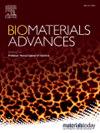银纳米粒子:开辟肺癌治疗的新前线
IF 5.5
2区 医学
Q2 MATERIALS SCIENCE, BIOMATERIALS
Materials Science & Engineering C-Materials for Biological Applications
Pub Date : 2025-06-20
DOI:10.1016/j.bioadv.2025.214395
引用次数: 0
摘要
肺癌仍然是全球癌症相关死亡的主要原因,占所有癌症死亡人数的18%。多药耐药(MDR)和全身毒性加剧了化疗等传统疗法的局限性,因此迫切需要创新的治疗策略。纳米技术,特别是银纳米颗粒(AgNPs),显示出通过调节关键转运蛋白和相关途径来克服耐多药的潜力,为减少副作用的位点特异性药物递送提供了一种有希望的方法。AgNPs在肺癌细胞系中表现出显著的细胞毒性和凋亡作用,其机制涉及基因调控、活性氧(ROS)产生和线粒体去极化。生物合成的AgNPs,特别是从植物提取物中提取的AgNPs,具有增强的生物相容性和降低的毒性。它们的抗癌潜力已在体外和体内模型中得到验证,显示出剂量依赖性的细胞活力降低、细胞周期阻滞和细胞凋亡诱导。此外,AgNPs可以调节肿瘤微环境并抑制血管生成,为靶向肺癌治疗铺平了道路。功能化AgNPs及其与光动力疗法的结合等进展进一步增强了它们的治疗潜力。然而,与脱靶毒性和临床转化相关的挑战仍然存在。为了充分利用AgNPs的潜力,弥合肺癌治疗中治疗疗效和安全性之间的差距,继续研究至关重要。本文章由计算机程序翻译,如有差异,请以英文原文为准。

Silver nanoparticles: Forging a new frontline in lung cancer therapy
Lung cancer remains the leading cause of cancer-related mortality worldwide, accounting for 18 % of all cancer deaths. The limitations of conventional therapies, such as chemotherapy, are exacerbated by multidrug resistance (MDR) and systemic toxicity, underscoring the urgent need for innovative treatment strategies. Nanotechnology, particularly silver nanoparticles (AgNPs), shows potential in overcoming MDR by modulating key transporters and associated pathways, providing a promising approach for site-specific drug delivery with reduced adverse effects. AgNPs exhibit significant cytotoxic and apoptotic effects in lung cancer cell lines through mechanisms involving gene regulation, reactive oxygen species (ROS) production, and mitochondrial depolarization. Biosynthesized AgNPs, particularly those derived from plant extracts, demonstrate enhanced biocompatibility and reduced toxicity. Their anticancer potential has been validated in both in vitro and in vivo models, showing dose-dependent reductions in cell viability, cell cycle arrest, and apoptosis induction. Furthermore, AgNPs can modulate the tumor microenvironment and inhibit angiogenesis, paving the way for targeted lung cancer therapies. Advances such as functionalized AgNPs and their integration into photodynamic therapy further enhance their therapeutic potential. However, challenges related to off-target toxicity and clinical translation remain. Continued research is essential to fully harness AgNPs' potential, bridging the gap between treatment efficacy and safety in lung cancer therapy.
求助全文
通过发布文献求助,成功后即可免费获取论文全文。
去求助
来源期刊
CiteScore
17.80
自引率
0.00%
发文量
501
审稿时长
27 days
期刊介绍:
Biomaterials Advances, previously known as Materials Science and Engineering: C-Materials for Biological Applications (P-ISSN: 0928-4931, E-ISSN: 1873-0191). Includes topics at the interface of the biomedical sciences and materials engineering. These topics include:
• Bioinspired and biomimetic materials for medical applications
• Materials of biological origin for medical applications
• Materials for "active" medical applications
• Self-assembling and self-healing materials for medical applications
• "Smart" (i.e., stimulus-response) materials for medical applications
• Ceramic, metallic, polymeric, and composite materials for medical applications
• Materials for in vivo sensing
• Materials for in vivo imaging
• Materials for delivery of pharmacologic agents and vaccines
• Novel approaches for characterizing and modeling materials for medical applications
Manuscripts on biological topics without a materials science component, or manuscripts on materials science without biological applications, will not be considered for publication in Materials Science and Engineering C. New submissions are first assessed for language, scope and originality (plagiarism check) and can be desk rejected before review if they need English language improvements, are out of scope or present excessive duplication with published sources.
Biomaterials Advances sits within Elsevier''s biomaterials science portfolio alongside Biomaterials, Materials Today Bio and Biomaterials and Biosystems. As part of the broader Materials Today family, Biomaterials Advances offers authors rigorous peer review, rapid decisions, and high visibility. We look forward to receiving your submissions!

 求助内容:
求助内容: 应助结果提醒方式:
应助结果提醒方式:


